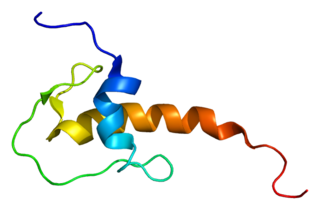
Keratin 1 is a member of the keratin family. It is specifically expressed in the spinous and granular layers of the epidermis with family member keratin 10. Mutations in this gene have been associated with the variants of bullous congenital ichthyosiform erythroderma in which the palms and soles of the feet are affected.

Keratin, type I cytoskeletal 4 also known as cytokeratin-4 (CK-4) or keratin-4 (K4) is a protein that in humans is encoded by the KRT4 gene.

Keratin 14 is a member of the type I keratin family of intermediate filament proteins. Keratin 14 was the first type I keratin sequence determined. Keratin 14 is also known as cytokeratin-14 (CK-14) or keratin-14 (KRT14). In humans it is encoded by the KRT14 gene.

Keratin, type I cytoskeletal 10 also known as cytokeratin-10 (CK-10) or keratin-10 (K10) is a protein that in humans is encoded by the KRT10 gene. Keratin 10 is a type I keratin.

Keratin 9 is a protein that in humans is encoded by the KRT9 gene.

Keratin, type I cytoskeletal 17 is a protein that in humans is encoded by the KRT17 gene.

Keratin 16 is a protein that in humans is encoded by the KRT16 gene.

ATP-binding cassette sub-family A member 12 also known as ATP-binding cassette transporter 12 is a protein that in humans is encoded by the ABCA12 gene.

Collagen XVII, previously called BP180, is a transmembrane protein which plays a critical role in maintaining the linkage between the intracellular and the extracellular structural elements involved in epidermal adhesion, identified by Diaz and colleagues in 1990.

Laminin subunit beta-3 is a protein that in humans is encoded by the LAMB3 gene.

Lympho-epithelial Kazal-type-related inhibitor (LEKTI) also known as serine protease inhibitor Kazal-type 5 (SPINK5) is a protein that in humans is encoded by the SPINK5 gene.

Loricrin is a protein that in humans is encoded by the LOR gene.

HR is a gene encoding Protein hairless.

Keratin, type II cuticular Hb1 is a protein that in humans is encoded by the KRT81 gene.

Keratin, type II cuticular Hb6 is a protein that in humans is encoded by the KRT86 gene.

Transmembrane channel-like 8 is a protein which in humans is encoded by the TMC8 gene.

Ichthyosis bullosa of Siemens is a type of familial, autosomal dominant ichthyosis, a rare skin disorder. It is also known as bullous congenital ichthyosiform erythroderma of Siemens or ichthyosis exfoliativa. It is a genetic disorder with no known cure which is estimated to affect about 1 in 500,000 people.
Trichorrhexis invaginata is a distinctive hair shaft abnormality that may occur sporadically, either in normal hair or with other hair shaft abnormalities, or regularly as a marker for Netherton's syndrome. The primary defect appears to be abnormal keratinization of the hair shaft in the keratogenous zone, allowing for intussusception of the fully keratinized and hard distal shaft into the incompletely keratinized and soft proximal portion of the shaft.

Camisa disease is the variant form of Vohwinkel syndrome, characterized by ichthyosis and normal hearing.
A keratin disease is a genetic disorder of one of the keratin genes. An example is monilethrix. The first to be identified was epidermolysis bullosa simplex.










